brake MERCEDES-BENZ AMG GT R-ROADSTER 2018 Owners Manual
[x] Cancel search | Manufacturer: MERCEDES-BENZ, Model Year: 2018, Model line: AMG GT R-ROADSTER, Model: MERCEDES-BENZ AMG GT R-ROADSTER 2018Pages: 473, PDF Size: 8.3 MB
Page 10 of 473
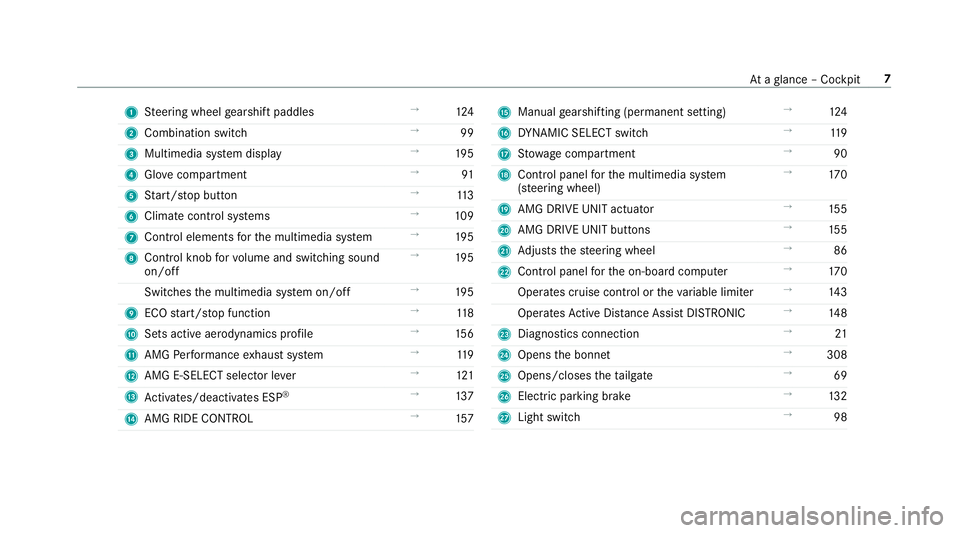
1
Steering wheel gearshift paddles ŌåÆ
124
2 Combination swit ch ŌåÆ
99
3 Multimedia sy stem display ŌåÆ
19 5
4 Glovecompa rtment ŌåÆ
91
5 Start/ stop button ŌåÆ
11 3
6 Climate cont rol sy stems ŌåÆ
109
7 Control elements forth e multimedia sy stem ŌåÆ
19 5
8 Control knob forvo lume and switching sound
on/off ŌåÆ
19 5
Switches the multimedia sy stem on/off ŌåÆ
19 5
9 ECO start/ stop function ŌåÆ
11 8
A Sets acti veaerodynamics profile ŌåÆ
15 6
B AMG Performance exhaust sy stem ŌåÆ
11 9
C AMG E-SELECT selector le verŌåÆ
121
D Activates/deacti vates ESP ®
ŌåÆ
137
E AMG RIDE CONTROL ŌåÆ
157 F
Manual gearshifting (permanent setting) ŌåÆ
124
G DYNA MIC SELECT switch ŌåÆ
11 9
H Stow age compartment ŌåÆ
90
I Control panel forth e multimedia sy stem
(s te ering wheel) ŌåÆ
17 0
J AMG DRIVE UNIT actuator ŌåÆ
15 5
K AMG DRIVE UNIT buttons ŌåÆ
15 5
L Adjusts thesteering wheel ŌåÆ
86
M Control panel forth e on-board computer ŌåÆ
17 0
Operates cruise contro l ortheva riable limiter ŌåÆ
14 3
Operates Active Dis tance Assi stDISTRONIC ŌåÆ
14 8
N Diagno stics connection ŌåÆ
21
O Opens the bonn et ŌåÆ
308
P Opens/closes theta ilgate ŌåÆ
69
Q Electric parking brake ŌåÆ
13 2
R Light switch ŌåÆ
98 At
aglance ŌĆō Cockpit 7
Page 12 of 473
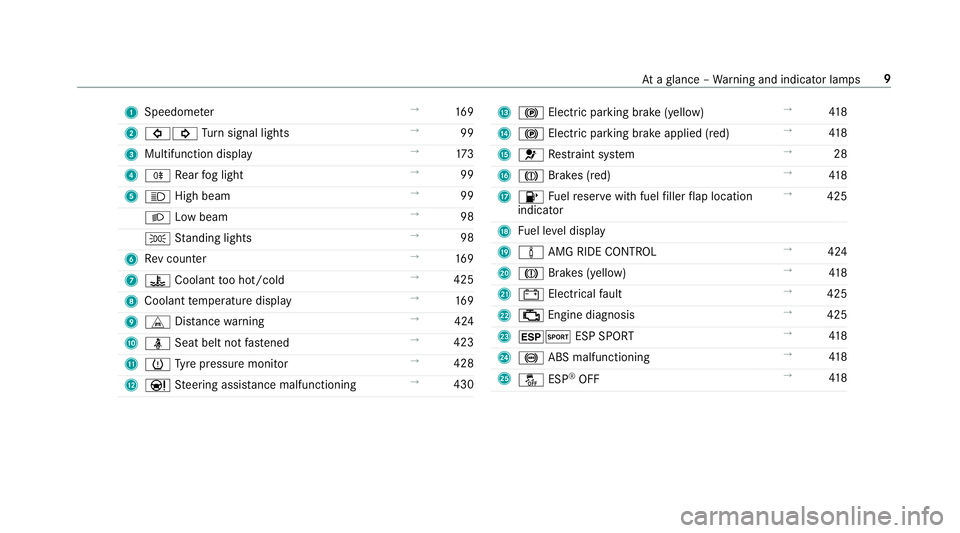
1
Speedom eter ŌåÆ
16 9
2 #! Turn signal lights ŌåÆ
99
3 Multifunction display ŌåÆ
173
4 R Rear fog light ŌåÆ
99
5 K High beam ŌåÆ
99
L Low beam ŌåÆ
98
T Standing lights ŌåÆ
98
6 Rev counter ŌåÆ
16 9
7 ? Coolant too hot/cold ŌåÆ
425
8 Coolant temp erature display ŌåÆ
16 9
9 L Distance warning ŌåÆ
424
A ├╝ Seat belt not fastened ŌåÆ
423
B h Tyre pressure monitor ŌåÆ
428
C ├É Steering assis tance malfunctioning ŌåÆ
430 D
! Electric pa rking brake (yellow) ŌåÆ
41 8
E ! Electric pa rking brake applied (red) ŌåÆ
41 8
F 6 Restra int sy stem ŌåÆ
28
G J Brakes (red) ŌåÆ
41 8
H 8 Fuelreser vewith fuel filler flap location
indicator ŌåÆ
425
I Fuel le vel display
J ├Ā AMG RIDE CONTROL ŌåÆ
424
K J Brakes (yellow) ŌåÆ
41 8
L # Electrical fault ŌåÆ
425
M ; Engine diagnosis ŌåÆ
425
N ┬▒M ESP SPORT ŌåÆ
41 8
O ! ABS malfunctioning ŌåÆ
41 8
P ├ź ESP┬«
OFF ŌåÆ
41 8 At
aglance ŌĆō Warning and indicator lamps 9
Page 21 of 473
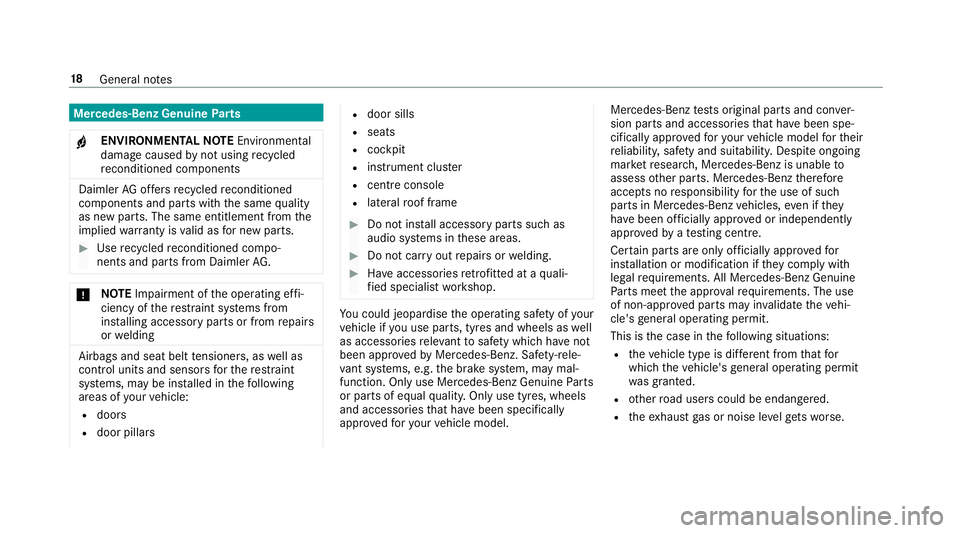
Mercedes-Benz Genuine
Parts
+ ENVIRONMENTAL
NOTEEnvironmental
dama gecaused bynot using recycled
re conditioned components Daimler
AGoffers recycled reconditioned
components and pa rts with the same quality
as new parts. The same entitlement from the
implied warranty is valid as for new parts. #
Use recycled reconditioned compoŌĆÉ
nents and pa rts from Daimler AG.*
NO
TEImpairment of the operating ef fiŌĆÉ
ciency of there stra int sy stems from
ins talling accessory parts or from repairs
or we lding Airbags and seat belt
tensioners, as well as
control units and sensors forth ere stra int
sy stems, may be ins talled in thefo llowing
areas of your vehicle:
R doors
R door pillars R
door sills
R seats
R cockpit
R instrument clus ter
R centre console
R late ra lro of frame #
Do not ins tall accessory parts such as
audio sy stems in these areas. #
Do not car ryout repairs or welding. #
Have accesso ries retrofitted at a qualiŌĆÉ
fi ed specialist workshop. Yo
u could jeopardise the operating saf ety of your
ve hicle if you use parts, tyres and wheels as well
as accessories releva nt tosaf ety which ha venot
been appr ovedby Mercedes-Benz. Saf ety-re leŌĆÉ
va nt sy stems, e.g. the brake sy stem, may malŌĆÉ
function. Only use Mercedes-Benz Genuine Parts
or parts of equal qualit y.Only use tyres, wheels
and accessories that ha vebeen specifically
appr ovedfo ryo ur vehicle model. Mercedes-Benz
tests original parts and con verŌĆÉ
sion parts and accessories that ha vebeen speŌĆÉ
cifically appr ovedfo ryo ur vehicle model forth eir
re liability, saf ety and suitabilit y.Despite ongoing
ma rket resear ch, Mercedes-Benz is unable to
assess other parts. Mercedes-Benz therefore
accepts no responsibility forth e use of such
parts in Mercedes-Benz vehicles, even if they
ha ve been of ficially appr oved or independently
appr ovedby ate sting centre.
Cer tain parts are only of ficially appr ovedfor
ins tallation or modification if they comply wi th
legal requirements. All Mercedes-Benz Genuine
Pa rts meet the appr oval requ irements. The use
of non-appr oved parts may in validate theve hiŌĆÉ
cle's general operating pe rmit.
This is the case in thefo llowing situations:
R theve hicle type is dif fere nt from that for
which theve hicle's general operating pe rmit
wa s granted.
R other road users could be endangered.
R theex haust gas or noise le velge ts wo rse. 18
General no tes
Page 27 of 473
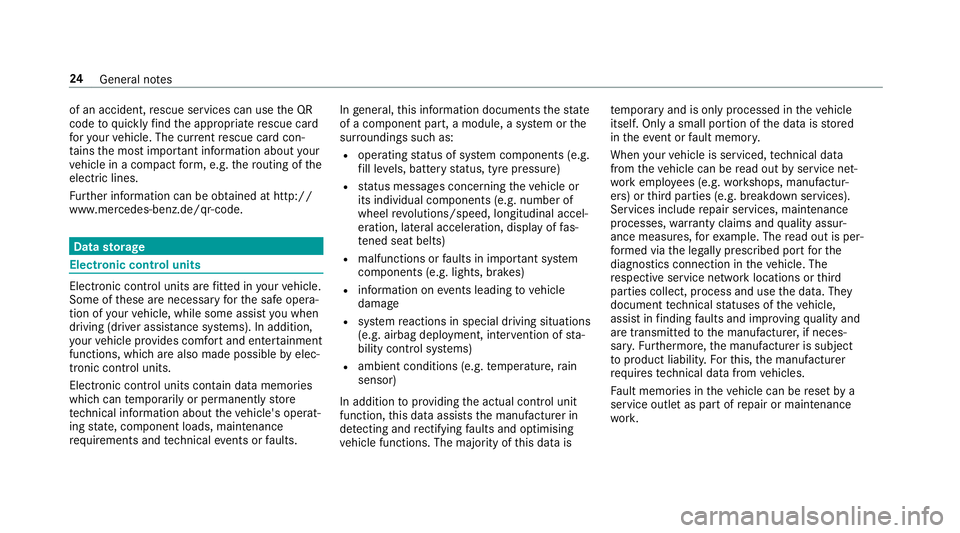
of an accident,
rescue services can use the QR
code toquickly find the appropriate rescue card
fo ryo ur vehicle. The cur rent rescue card conŌĆÉ
ta ins the most impor tant information about your
ve hicle in a compact form , e.g. thero uting of the
electric lines.
Fu rther information can be obtained at http://
www.mercedes-benz.de/qr-code. Data
storage Electronic control units
Elect
ronic control units are fitted in your vehicle.
Some of these are necessary forth e safe operaŌĆÉ
tion of your vehicle, while some assist you when
driving (driver assis tance sy stems). In addition,
yo ur vehicle pr ovides com fort and enter tainment
functions, which are also made possible byelecŌĆÉ
tronic control units.
Elect ronic control units contain da tamemories
which can temp orarily or permanently store
te ch nical information about theve hicle's operatŌĆÉ
ing state, component loads, main tenance
re qu irements and tech nical events or faults. In
general, this information documents thest ate
of a component part, a module, a sy stem or the
sur roundings such as:
R operating status of sy stem components (e.g.
fi ll le vels, battery status, tyre pressure)
R status messages concerning theve hicle or
its individual components (e.g. number of
wheel revo lutions/speed, longitudinal accelŌĆÉ
eration, lateral acceleration, display of fasŌĆÉ
te ned seat belts)
R malfunctions or faults in impor tant sy stem
components (e.g. lights, brakes)
R information on events leading tovehicle
damage
R system reactions in special driving situations
(e.g. airbag deployment, inter vention of staŌĆÉ
bility control sy stems)
R ambient conditions (e.g. temp erature, rain
sensor)
In addition toprov iding the actual control unit
function, this data assists the manufacturer in
de tecting and rectifying faults and optimising
ve hicle functions. The majority of this data is te
mp orary and is only processed in theve hicle
itself. Only a small portion of the data is stored
in theeve nt or fault memor y.
When your vehicle is serviced, tech nical da ta
from theve hicle can be read out byservice netŌĆÉ
wo rkemplo yees (e.g. workshops, manufacturŌĆÉ
ers) or third parties (e.g. breakdown services).
Services include repair services, maintenance
processes, warranty claims and quality assurŌĆÉ
ance measures, forex ample. The read out is perŌĆÉ
fo rm ed via the legally prescribed port forthe
diagnostics connection in theve hicle. The
re spective service network locations or third
parties collect, process and use the data. They
document tech nical statuses of theve hicle,
assist in finding faults and impr oving quality and
are transmitted tothe manufacturer, if necesŌĆÉ
sar y.Fu rthermore, the manufacturer is subject
to product liability. Forth is, the manufacturer
requ irestech nical da tafrom vehicles.
Fa ult memories in theve hicle can be reset by a
service outlet as part of repair or maintenance
wo rk. 24
General no tes
Page 50 of 473
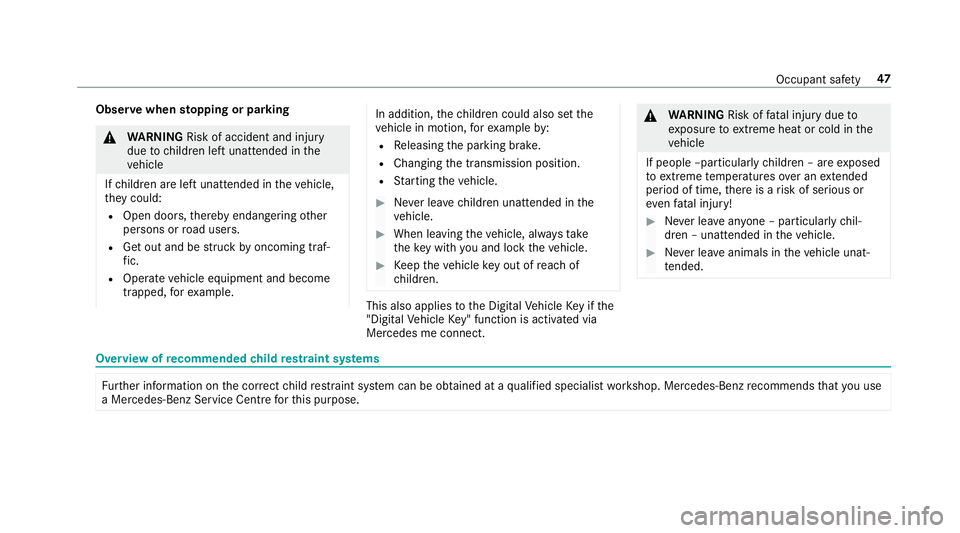
Obser
vewhen stopping or parking &
WARNING Risk of accident and inju ry
due tochildren left unat tended in the
ve hicle
If ch ildren are left unat tended in theve hicle,
th ey could:
R Open doo rs,th ereby endangering other
persons or road users.
R Get out and be stru ck byoncoming trafŌĆÉ
fi c.
R Ope rate ve hicle equipment and become
trapped, forex ample. In addition,
thech ildren could also set the
ve hicle in motion, forex ample by:
R Releasing the parking brake.
R Changing the transmission position.
R Starting theve hicle. #
Never lea vechildren unat tended in the
ve hicle. #
When leaving theve hicle, alw aysta ke
th eke y with you and lock theve hicle. #
Keep theve hicle key out of reach of
ch ildren. This also applies
tothe Digital Vehicle Key if the
"Digital Vehicle Key" function is activated via
Mercedes me connect. &
WARNING Risk offata l injury due to
ex posure toextreme heat or cold in the
ve hicle
If people ŌĆōparticularly children ŌĆō are exposed
to extreme temp eratures over an extended
pe riod of time, there is a risk of serious or
ev en fata l injury! #
Never lea veanyone ŌĆō pa rticularly chilŌĆÉ
dren ŌĆō unat tended in theve hicle. #
Never lea veanimals in theve hicle unatŌĆÉ
te nded. Overvi
ewofrecommended child restra int sy stems Fu
rther information on the cor rect child restra int sy stem can be obtained at a qualified specialist workshop. Mercedes-Benz recommends that you use
a Mercedes-Benz Service Centre forth is purpose. Occupant saf
ety47
Page 64 of 473
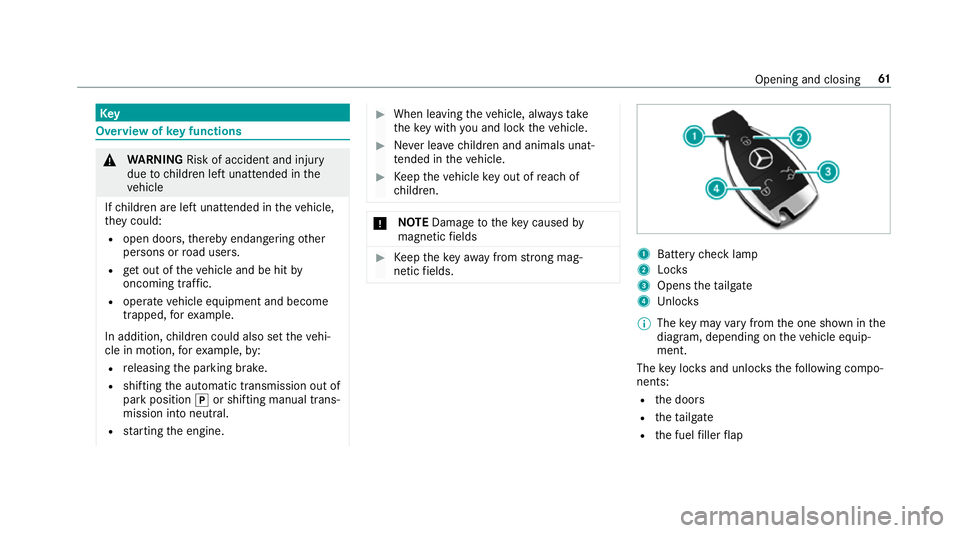
Key
Overview of
key functions &
WARNING Risk of accident and inju ry
due tochildren left unat tended in the
ve hicle
If ch ildren are left unat tended in theve hicle,
th ey could:
R open doo rs,th ereby endangering other
persons or road users.
R get out of theve hicle and be hit by
oncoming traf fic.
R ope rate ve hicle equipment and become
trapped, forex ample.
In addition, children could also set theve hiŌĆÉ
cle in motion, forex ample, by:
R releasing the parking brake.
R shifting the automatic transmission out of
park position jor shifting manual transŌĆÉ
mission into neutral.
R starting the engine. #
When leaving theve hicle, alw aysta ke
th eke y with you and lock theve hicle. #
Never lea vechildren and animals unatŌĆÉ
te nded in theve hicle. #
Keep theve hicle key out of reach of
ch ildren. *
NO
TEDama getotheke y caused by
magnetic fields #
Keep theke yaw ay from strong magŌĆÉ
netic fields. 1
Battery check lamp
2 Locks
3 Opens theta ilgate
4 Unloc ks
% The key may vary from the one shown in the
diagram, depending on theve hicle equipŌĆÉ
ment.
The key loc ksand unlo cksth efo llowing compoŌĆÉ
nents:
R the doors
R theta ilgate
R the fuel filler flap Opening and closing
61
Page 103 of 473
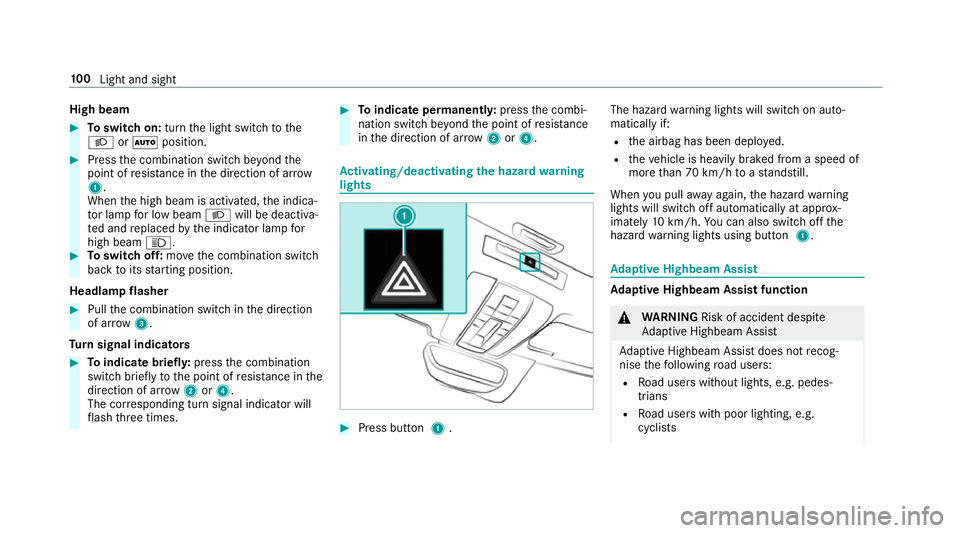
High beam
#
Toswitch on: turnthe light switch tothe
L or├ā position. #
Press the combination switch be yond the
point of resis tance in the direction of ar row
1 .
When the high beam is activated, the indicaŌĆÉ
to r lamp for low beam Lwill be deactivaŌĆÉ
te d and replaced bythe indicator lamp for
high beam K. #
Toswitch off: movethe combination switch
back toits starting position.
Headla mpflasher #
Pull the combination switch in the direction
of ar row3.
Tu rn signal indicators #
Toindicate briefl y:press the combination
switch briefly tothe point of resis tance in the
direction of ar row2or4.
The cor responding turn signal indicator will
fl ash thre e times. #
Toindicate permanentl y:press the combiŌĆÉ
nation switch be yond the point of resis tance
in the direction of ar row2or4. Ac
tivating/deactivating the hazard warning
lights #
Press button 1. The hazard
warning lights will switch on autoŌĆÉ
matically if:
R the airbag has been deplo yed.
R theve hicle is heavily braked from a speed of
more than 70 km/h toast andstill.
When you pull away again, the hazard warning
lights will switch off automatically at appr oxŌĆÉ
imately 10km/h. You can also swit choff the
hazard warning lights using button 1. Ad
aptive Highbeam Assist Ad
aptive Highbeam Assist function &
WARNING Risk of accident despi te
Ad aptive Highbeam Assist
Ad aptive Highbeam Assist does not recogŌĆÉ
nise thefo llowing road users:
R Road users without lights, e.g. pedesŌĆÉ
trians
R Road users with poor lighting, e.g.
cyclists 100
Light and sight
Page 116 of 473
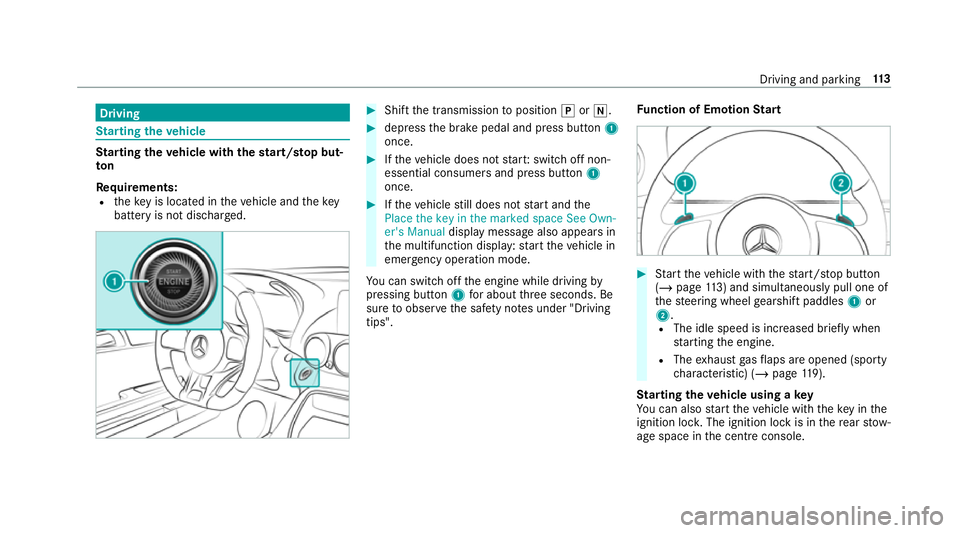
Driving
St
arting theve hicle St
arting theve hicle with thest art/s top butŌĆÉ
ton
Requ irements:
R theke y is located in theve hicle and thekey
battery is not dischar ged. #
Shift the transmission toposition jori. #
depress the brake pedal and press button 1
once. #
Ifth eve hicle does not star t:switch off non-
essential consumers and press button 1
once. #
Ifth eve hicle still does not start and the
Place the key in the marked space See Own-
er's Manual display message also appears in
th e multifunction display: start theve hicle in
emer gency operation mode.
Yo u can swit choff the engine while driving by
pressing button 1for about thre e seconds. Be
sure toobser vethe saf ety no tes under "Driving
tips". Fu
nction of Emotion Start #
Start theve hicle with thest art/ stop button
(/ page 113) and simultaneous ly pull one of
th esteering wheel gearshift paddles 1or
2.
R The idle speed is inc reased brief ly when
st arting the engine.
R The exhaust gasflaps are opened (spo rty
ch aracteristic) (/ page119).
St arting theve hicle using a key
Yo u can also start theve hicle with theke y in the
ignition loc k.The ignition lock is in there ar stowŌĆÉ
age space in the cent reconsole. Driving and pa
rking 11 3
Page 117 of 473
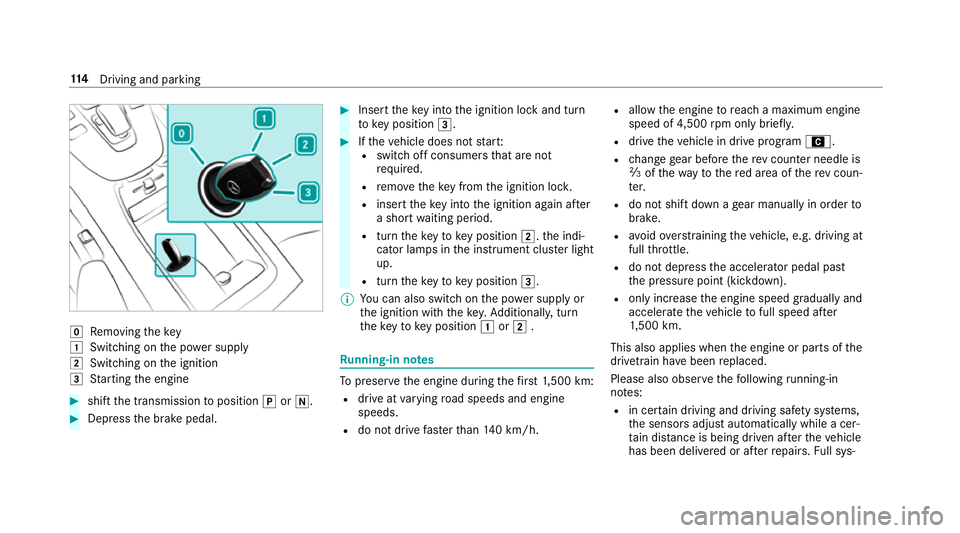
g
Removing thekey
1 Switching on the po wer supp ly
2 Switching on the ignition
3 Starting the engine #
shift the transmission toposition jori. #
Depress the brake pedal. #
Insert theke y in tothe ignition lock and turn
to key position 3. #
Ifth eve hicle does not star t:
R switch off consumers that are not
requ ired.
R remo vetheke y from the ignition loc k.
R inse rttheke y in tothe ignition again af ter
a short waiting period.
R turn theke yto key position 2.the indiŌĆÉ
cator lamps in the instrument clus ter light
up.
R turn theke yto key position 3.
% You can also swit chon the po wer supp lyor
th e ignition with thekey. Additionall y,turn
th eke yto key position 1or2 . Ru
nning-in no tes To
preser vethe engine during thefirs t1, 500 km:
R drive at varying road speeds and engine
speeds.
R do not drive fasterthan 140 km/h. R
allow the engine toreach a maximum engine
speed of 4,500 rpm on ly brie fly.
R drive theve hicle in drive program A.
R change gear before there v counter needle is
├ö ofthewa yto there d area of there v counŌĆÉ
te r.
R do not shift down a gear manually in order to
brake.
R avoidove rstraining theve hicle, e.g. driving at
full thro ttle.
R do not depress the accelera tor pedal past
th e pressure point (kickdown).
R only increase the engine speed gradually and
accelera tetheve hicle tofull speed af ter
1, 500 km.
This also applies when the engine or parts of the
driv etra in ha vebeen replaced.
Please also obser vethefo llowing running-in
no tes:
R in cer tain driving and driving saf ety sy stems,
th e sensors adjust automatically while a cerŌĆÉ
ta in dis tance is being driven af terth eve hicle
has been delivered or af terre pairs. Full sysŌĆÉ 11 4
Driving and pa rking
Page 118 of 473
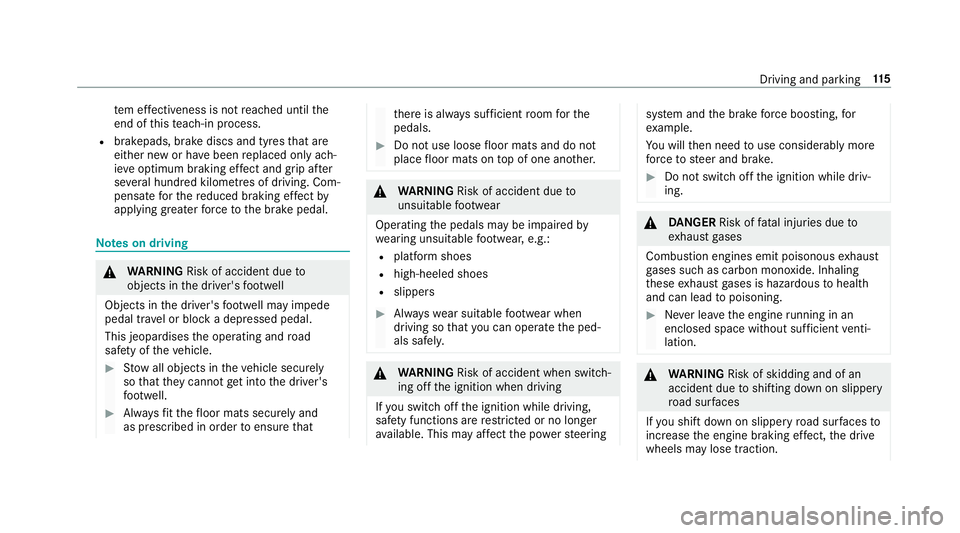
te
m ef fectiveness is not reached until the
end of this teach-in process.
R brakepads, brake discs and tyres that are
either new or ha vebeen replaced only achŌĆÉ
ie ve optimum braking ef fect and grip af ter
se veral hundred kilom etre s of driving. ComŌĆÉ
pensate forth ere duced braking ef fect by
applying greater forc eto the brake pedal. Note
s on driving &
WARNING Risk of accident due to
objects in the driver's foot we ll
Objects in the driver's foot we ll may impede
pedal tra vel or block a depressed pedal.
This jeopardises the operating and road
saf ety of theve hicle. #
Stow all objects in theve hicle securely
so that they cannot getinto the driver's
fo ot we ll. #
Alw aysfit th efloor mats securely and
as prescribed in order toensure that th
ere is alw ays suf ficient room forthe
pedals. #
Do not use loose floor mats and do not
place floor mats on top of one ano ther. &
WARNING Risk of accident due to
unsuitable foot we ar
Operating the pedals may be impaired by
we aring unsuitable foot we ar, e.g.:
R plat form shoes
R high-heeled shoes
R slippers #
Alw ayswe ar suitable foot we ar when
driving so that you can operate the pedŌĆÉ
als safel y. &
WARNING Risk of accident when switchŌĆÉ
ing off the ignition when driving
If yo u swit choff the ignition while driving,
saf ety functions are restricted or no longer
av ailable. This may af fect the po werst eering sy
stem and the brake forc e boosting, for
ex ample.
Yo u will then need touse considerably more
fo rc eto steer and brake. #
Do not switch off the ignition while drivŌĆÉ
ing. &
DANG ER Risk of fata l injuries due to
ex haust gases
Combustion engines emit poisonous exhaust
ga ses such as carbon monoxide. Inhaling
th ese exhaust gases is hazardous tohealth
and can lead topoisoning. #
Never lea vethe engine running in an
enclosed space wi thout suf ficient ventiŌĆÉ
lation. &
WARNING Risk of skidding and of an
accident due toshifting down on slippery
ro ad sur faces
If yo u shift down on slippery road sur faces to
inc rease the engine braking ef fect, the drive
wheels may lose traction. Driving and parking
11 5